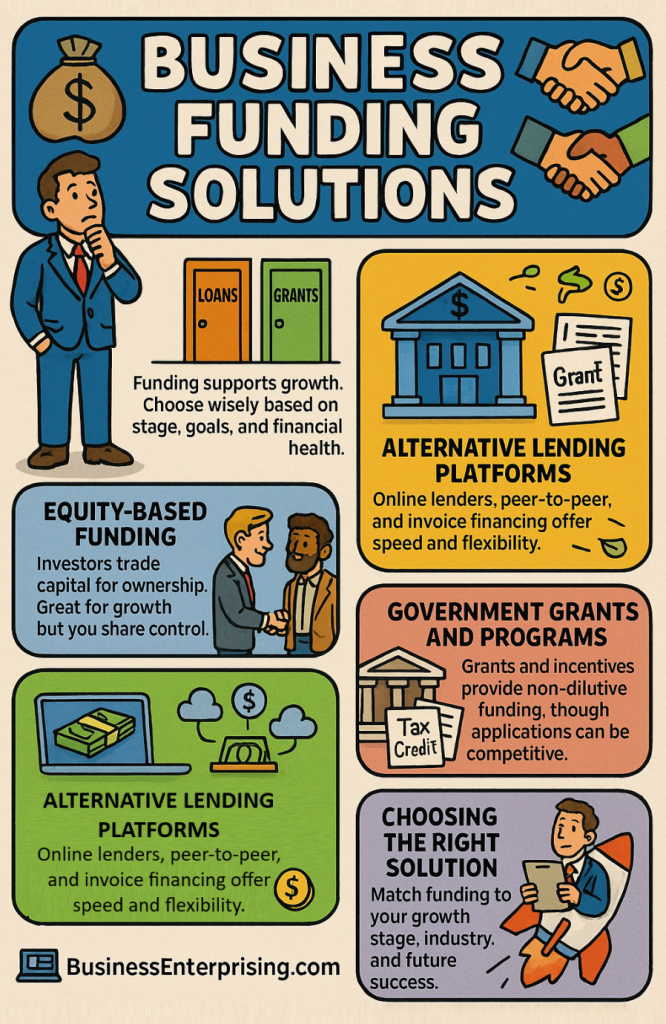
Funding needs vary by business type, stage, and financial health. A startup may require seed capital, while an established company may need expansion funds. Therefore, your best choice depends on how much control you want to retain and how quickly you need access to money. Additionally, your industry often influences which sources of funding are realistic and which are less practical.
Some financing options involve debt with fixed repayment terms, while others involve equity and shared ownership. Therefore, you must weigh the long-term effects of your choice. Additionally, you should assess how each option affects your flexibility, cash flow, and overall control of the business. Clear planning makes it easier to match the right funding to your goals.
When you understand your needs and compare available sources, you reduce risks and avoid unnecessary stress. Therefore, taking time to review traditional loans, equity financing, grants, and community-based support can give you clarity. Additionally, mixing different types of funding may provide balance between cost and accessibility. A thoughtful approach can help you build a stronger foundation for both immediate and future growth.
Traditional Financing Options
Traditional financing options remain a common choice for many business owners who want stability and structure in their funding. Bank loans, credit lines, and SBA-backed loans each provide specific advantages, but they also carry requirements that you must carefully consider. You want to know what fits your business before you apply. Lenders usually review your credit history, revenue, and collateral before approving an application, so preparation is important.
Bank loans often appeal to owners who want a clear repayment plan and predictable interest rates. These loans can provide larger sums, making them useful for equipment purchases or major expansions. However, banks often require strong credit, solid cash flow, and collateral to reduce their risk. If you lack these, approval may be difficult. Therefore, many small or growing companies face obstacles with traditional bank financing.
Credit lines, by comparison, offer more flexibility. You can borrow what you need, when you need it, and pay interest only on the balance. This can help with cash flow gaps or short-term expenses. Additionally, you can reuse a credit line once it is repaid, giving your business ongoing access to funds. Yet credit lines often come with higher interest rates and fees compared to traditional term loans.
SBA-backed loans combine government guarantees with private lending, which lowers risk for the lender and increases access for you. These loans can support smaller companies that cannot qualify for conventional bank loans. They may offer longer repayment terms and lower interest rates, making them attractive for working capital or equipment needs. However, the process can be lengthy and requires significant documentation.
Equity-Based Funding
Equity-based funding gives you access to capital without taking on debt. Instead, you offer ownership in your business to outside investors. Angel investors, venture capital firms, and private equity groups each provide funds in exchange for shares. While this reduces your control, it can accelerate growth when used strategically.
Angel investors usually provide early support for small or growing businesses. They often focus on your potential and your ideas rather than only your financial history. Therefore, they may take on higher risk in return for equity. Additionally, they sometimes provide mentorship and connections that help you strengthen your operations. However, they also expect a clear plan for growth and a chance for future returns.
Venture capital firms usually target companies with proven models that can scale quickly. They often bring large amounts of funding but also demand a strong influence on how you run your business. Therefore, you must prepare to share decision-making power with experienced investors. Additionally, venture capital often requires rapid growth, which may not match every business model.
Private equity groups generally invest in established companies seeking expansion or restructuring. They provide significant funding, but they expect detailed financial performance and long-term profitability. Therefore, your records, operations, and strategy must be organized and appealing. Additionally, private equity investors often push for efficiency improvements or management changes.
When you explore these business funding solutions, remember that investors always look for returns that outweigh their risk. They want solid financial data, growth opportunities, and a clear plan. Equity financing can give you resources that debt cannot, but it requires giving up part of your ownership. Choosing this path depends on your willingness to share control for the benefit of greater growth.
Alternative Lending Platforms
Alternative lending platforms have become an important option for many businesses that want faster and more flexible access to funding. Unlike banks, these platforms often have streamlined applications and fewer requirements. Therefore, you can apply quickly and receive decisions in days instead of weeks. This speed allows you to act on opportunities without long delays.
Online lenders provide convenience through digital applications and quick funding. Additionally, many offer products that range from short-term loans to revolving credit. However, you should expect higher interest rates compared to banks. Lenders take on greater risk, so they offset it with increased costs. Still, the accessibility makes them valuable for businesses that cannot qualify for traditional financing.
Peer-to-peer lending connects you directly with individual investors through online platforms. This method often provides more flexible terms compared to conventional lenders. Additionally, you can sometimes negotiate rates based on your credit profile and business performance. However, you still need a strong plan to attract investors. They want confidence that their funds will generate consistent returns.
Invoice financing is another option that helps improve cash flow. Instead of waiting for customer payments, you receive funds upfront from a financing company. Therefore, you gain working capital without taking on traditional debt. Additionally, this approach helps stabilize operations during slow payment cycles. The trade-off is that you give up a portion of your invoice value in fees.
When reviewing business funding solutions, you should weigh cost against convenience. Alternative lending can expand your options, but it requires careful planning. By considering speed, flexibility, and long-term impact, you can choose a platform that supports your goals.
Government Grants and Programs
Government grants and programs can provide you with valuable support without requiring repayment or equity. These opportunities help businesses grow while keeping ownership intact. Federal, state, and local agencies each offer different options, making it important for you to research what fits your needs. Therefore, grants and tax incentives can become a reliable part of your financial strategy.
Federal programs often provide funding for innovation, research, or small business development. Additionally, some focus on industries like technology, healthcare, or energy. These grants can be competitive, so you must prepare strong applications that highlight potential impact. However, the benefit is non-dilutive capital that allows you to expand without taking on debt.
State governments also provide grants and credits to attract and support local businesses. Therefore, you may qualify for tax incentives if you create jobs or invest in your community. Additionally, some states offer matching funds that supplement federal programs. These options can reduce expenses and free up cash for operations or expansion.
Local programs often target small businesses and startups. Municipalities may provide grants to encourage growth in certain neighborhoods or industries. Additionally, local economic development offices can connect you with resources and guidance. While amounts may be smaller, they can still support key business activities.
Industry-specific programs add another layer of opportunity. Therefore, if you work in manufacturing, technology, or agriculture, you may find grants tailored to your field. These programs often support innovation, training, and sustainability.
When exploring business funding solutions, you should consider grants and programs alongside other financing methods. They may not cover all your needs, but they can strengthen your financial base and reduce pressure on your cash flow.
Crowdfunding and Community-Based Funding
Crowdfunding and community-based funding give you the chance to raise money directly from supporters who believe in your idea. Platforms like Kickstarter and Indiegogo let you present a project and invite backers to contribute. Therefore, you gain access to capital while also building awareness for your business. Additionally, successful campaigns often provide validation that your idea resonates with a larger audience.
Reward-based crowdfunding allows you to offer products, experiences, or special perks in exchange for contributions. This approach can generate excitement and create loyal customers even before your business fully launches. However, you must carefully plan costs, timelines, and delivery to maintain trust. Clear communication and transparency help you keep backers engaged.
Equity crowdfunding provides another path where supporters receive ownership shares in your business. Therefore, you can raise larger sums while giving investors a stake in future success. Additionally, equity platforms often attract individuals who want both financial returns and participation in growth. However, this method requires compliance with regulations and careful preparation of financial details.
Community-based funding also includes local networks and cooperatives. These efforts rely on personal connections and shared goals to generate support. Therefore, you may find strong backers within your own community. Additionally, these relationships can lead to ongoing partnerships that support your business long after the campaign ends.
When exploring business funding solutions, you should focus on preparation and presentation. Strong visuals, clear goals, and regular updates keep supporters engaged. Additionally, setting realistic targets helps you deliver on promises. Crowdfunding can provide capital, visibility, and community support when you approach it with strategy and commitment.
Choosing the Right Solution for Your Business
Choosing the right funding option depends on knowing where your business stands and where you want it to go. Each stage of growth brings different needs, so your choice should reflect both short-term demands and long-term plans. Therefore, it helps to assess your current financial health before committing to any form of financing.
If your business is young, you may need funding that offers flexibility and accessibility. Online lenders or angel investors can often support early stages when traditional banks are less willing. Additionally, these options may provide faster approvals and more adaptable terms. However, you must still weigh the cost of capital against your potential returns.
For established businesses with proven cash flow, traditional loans or SBA-backed programs may be better fits. These options often provide stability and structured repayment schedules. Therefore, you can finance equipment, expansion, or working capital without giving up equity. Additionally, your history of revenue and credit performance may improve approval chances with lenders.
Industry focus also matters when evaluating funding. Some grants and programs specifically target sectors like technology, manufacturing, or healthcare. Therefore, you should explore opportunities that align with your field. Additionally, specialized funding can give you non-dilutive support that reduces pressure on your resources.
Your long-term goals should guide your final decision. If maintaining control is important, debt options may be more suitable than equity financing. However, if rapid growth is your aim, investors may bring both capital and expertise. By weighing growth stage, industry, and financial health, you can select business funding solutions that fit your goals.
Conclusion
Finding the right funding option requires balancing your current needs with your future goals. You must consider cost, control, and flexibility when reviewing your choices. Therefore, taking time to evaluate your growth stage, industry focus, and financial health will guide you toward better decisions.
Traditional loans, equity financing, and alternative lending each have strengths and limits. Additionally, government grants and community-based support add opportunities that may align with your plans. However, not every option will suit your business model. You should compare repayment terms, ownership impact, and the speed of funding before moving forward.
Your ability to prepare strong applications and financial records also affects your results. Therefore, building a clear business plan and accurate reporting helps you attract lenders or investors. Additionally, keeping realistic expectations will protect you from taking on obligations that limit flexibility. Careful planning keeps your focus on growth rather than repayment stress.
When considering business funding solutions, think about more than immediate cash. The right choice should support sustainable progress while keeping your long-term vision intact. Additionally, you should remain open to revisiting your funding mix as your business evolves. New opportunities may arise, and your priorities may shift with time.
By reviewing all available options with care, you give your business the best chance to thrive. Therefore, weigh benefits against risks, think strategically, and pursue funding that aligns with your values. With thoughtful selection, you can create a financial foundation that supports your growth today and well into the future.



